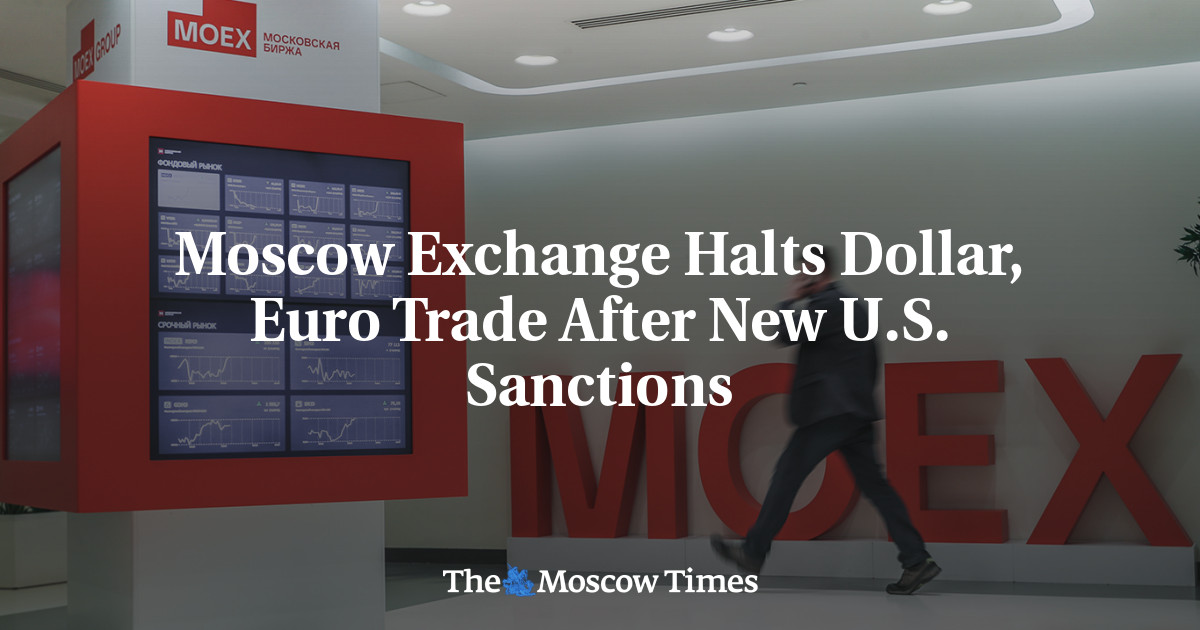
The Moscow Exchange on Thursday suspended trading in dollars and euros after it was sanctioned by the United States in a new raft of restrictions aimed at hindering Russia’s ability to wage war in Ukraine.
“Due to the introduction of restrictive measures by the United States against the Moscow Exchange Group… from June 13, 2024, trading on the Moscow Exchange markets will be conducted… with the exception of instruments with settlements in U.S. dollars and euros,” the exchange said in a statement.
“In the face of new challenges, the Moscow Exchange will continue to provide clients with access to all segments of the trading platform,” it added.
Russia’s National Clearing Center, which acts as an intermediary in foreign exchange transactions at the Moscow Exchange, was also hit by U.S. sanctions.
The U.S. Treasury Department on Wednesday widened sanctions against Russia aimed at cutting the flow of money and goods to Moscow as it continues to wage war on neighboring Ukraine. The sanctions targeted more than 300 entities, including those in Russia and countries like China, Turkey and the United Arab Emirates.
“Vladimir Putin has approved a series of measures to further attract capital through [the Moscow Exchange] from both Russian and non-Russian persons from ‘friendly countries’,” the U.S. Treasury Department said in its announcement of the new sanctions.
That, it said, has provided “opportunities for both Russians and non-Russians to profit from the Kremlin’s war machine by making investments in Russian sovereign debt, Russian corporations, and leading Russian defense entities.”
The new sanctions will take full effect on Aug. 13.
Companies and individuals in Russia will still be able to buy and sell euros and dollars through lenders, and the Russian Central Bank assured that all deposits in foreign currencies would not be impacted.
While the U.S. sanctions against the Moscow Exchange will complicate currency transactions, experts say they will have a limited impact on the ruble’s exchange rate.
“We do not expect a significant effect on the ruble-dollar exchange rate, so our forecast for the rest of the year remains in the range of 90-95 rubles/USD,” said Sofia Donets, the chief economist at T-Bank Investments.
“The new package of sanctions once again reminds us that the sanctions regime continues to evolve, increasing the risks of investing in alternative currencies and jurisdictions for Russians,” she added.
Others say the ruble will see greater volatility following the U.S. Treasury Department’s announcement.
“Sanctions will affect the exchange rate only secondarily, to the extent that they make the ruble more volatile, and therefore either increase the neutral ruble rate or the equilibrium ratio of capital outflow to GDP,” wrote Alexander Isakov, Bloomberg’s chief economist for Russia.
“Sanctions on the [Moscow Exchange] will reduce competition in the currency conversion market, allowing banks to expand spreads against customers,” he added.
The Moscow Exchange index fell by 3.5-4% at the start of trading on Thursday morning, while shares of the exchange itself dropped by 15%.